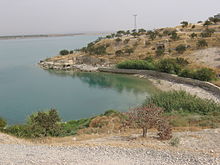Zeugma (‹See Tfd›Greek: Ζεῦγμα; Syriac: ܙܘܓܡܐ) was an ancient Hellenistic era Greek and then Roman city of Commagene; located in modern Gaziantep Province, Turkey. It was named for the bridge of boats, or zeugma,[1] that crossed the Euphrates at that location.[2] Zeugma Mosaic Museum contains mosaics from the site, and is one of the largest mosaic museums in the world.
Ζεῦγμα | |
 Parts of Zeugma have become submerged in the Euphrates River since the construction of the Birecik Dam | |
| Location | Belkis, Gaziantep Province, Turkey |
|---|---|
| Region | Commagene |
| Coordinates | 37°3′31″N 37°51′57″E / 37.05861°N 37.86583°E |
| Type | Settlement |
| History | |
| Builder | Seleucus I Nicator |
| Founded | 300 BC |
| Site notes | |
| Condition | Partially submerged |
History
editZeugma was founded in the early 3rd century BC as the city of Seleucia by Seleucus I Nicator, a Diadochus (successor) to Alexander the Great and Macedonian founder of the Seleucid Kingdom, on the site where he had the first bridge over the Euphrates built.[3] In 64 BC, the Roman Republic gained control of the city. Zeugma was of great importance to the Roman Empire as it was located at a strategically important place. Up to 70,000 people lived in the city, and it became a center for the military and commerce for the ancient Romans.[2] In 253 AD, it was destroyed by the Sassanids, but was later rebuilt.[3]
In late antiquity, Zeugma was a diocese of the early Roman church, but the place seems to have been abandoned in the 7th century due to Sassanid Persian and then Arab raids by the Umayyad Caliphate. Arabs lived there temporarily in the Middle Ages. By the 17th century the Ottoman Turkish village of Belkis was built near the ruins.
Preservation
editInitially the site was excavated sporadically, but in 2000, was flooded during construction of the Birecik Dam.[4] With only a fraction of the site excavated, archaeologists feared that many mosaics would be permanently lost.[5] After reading about it in The New York Times, and with only few months left, American philanthropist David W. Packard donated USD 5 million to fund an emergency excavation of the archaeological site, allowing archaeologists to preserve the mosaics that would otherwise be inundated by the dam.[6][7] The mosaics that were excavated were initially stored at the Gaziantep Museum, and are nowadays displayed at the Zeugma Mosaic Museum.[8]
Zeugma has been on the UNESCO World Heritage Site tentative list since 2012. Extant archaeological remains at the site include "the Hellenistic Agora, the Roman Agora, two sanctuaries, the stadium, the theatre, two bathhouses, the Roman legionary base, administrative structures of the Roman legion, the majority of the residential quarters, Hellenistic and Roman city walls, and the East, South and West necropoles."[9]
Three large glass mosaics were discovered at Zeugma in 2014, including one depicting the nine muses.[10]
The Zeugma Mosaic Museum attracted a record 340,569 visitors in 2019, according to the Turkish Culture and Tourism Ministry.[11]
Gallery
edit-
Zeugma, the lake
-
Zeugma excavations
-
Zeugma excavations and dam
-
Zeugma, the dam nearby
-
Zeugma excavations
-
Zeugma excavations
-
Zeugma excavations
-
Zeugma excavations
-
Zeugma excavations
-
Zeugma excavations
-
Zeugma excavations
-
Zeugma excavations
See also
editReferences
edit- ^ ζεῦγμα. Liddell, Henry George; Scott, Robert; A Greek–English Lexicon at the Perseus Project.
- ^ a b "Museum of Roman Mosaics to Open in Turkey". www.luxurytravelmagazine.com. Retrieved 2020-03-28.
- ^ a b "Remarkably Pristine Ancient Greek Mosaics Uncovered in Turkish City of Zeugma". mymodernmet.com. 24 November 2014.
- ^ Kinzer, Stephen (2000-07-03). "A Race to Save Roman Splendors From Drowning". The New York Times. ISSN 0362-4331. Retrieved 2021-11-22.
- ^ Kinzer, Stephen (2000-05-07). "Dam in Turkey May Soon Flood A '2nd Pompeii'". The New York Times. ISSN 0362-4331. Retrieved 2021-11-22.
- ^ "Zeugma finds a "secret" patron". arsiv.ntv.com.tr. 2000-08-27. Retrieved 2021-11-22.
- ^ Packard, David W. (2013). "Excavations at Zeugma" (PDF).
- ^ Aylward, William (2013). Excavations at Zeugma: Conducted by Oxford Archaeology. Packard Humanities Institute. ISBN 978-1-938325-29-8.
- ^ "Archeological Site of Zeugma". UNESCO World Heritage Centre. Retrieved 2020-05-05.
- ^ "Stunning Mosaics Uncovered in Ancient City of Zeugma | Archaeology | Sci-News.com". Breaking Science News | Sci-News.com. 28 November 2014. Retrieved 2020-05-05.
- ^ AA, Daily Sabah with (2020-01-22). "Record number of tourists visit Turkey's Zeugma Mosaic Museum". Daily Sabah. Retrieved 2020-05-05.
Further reading
edit- ICOMOS Heritage at Risk 2001/2002: Zeugma, Turkey, Icomos Heritage at Risk 2001/2002.
- Özgen Acar (September–October 2000). "Troubled Waters". Archaeology Magazine, Volume 53 Number 5. Archived from the original on 2012-03-29. Retrieved 2019-12-30.
- Stephen Kinzer (July 3, 2000). "A Race to Save Roman Splendors From Drowning". The New York Times.
- Lisa Krause (February 2, 2001). "Website Pulls Together the Strands of Turkey's Past". National Geographic News. Archived from the original on June 11, 2001.
- "Museum of Roman Mosaics to Open in Turkey". Luxury Travel Magazine.
- Kennedy, David. The Twin Towns of Zeugma on the Euphrates: Rescue Work and Historical Studies (Journal of Roman Archaeology Supplementary Series). Portsmouth, RI: Journal of Roman Archaeology, 1998.
External links
edit- This article incorporates text from a publication now in the public domain: Herbermann, Charles, ed. (1913). "Zeugma". Catholic Encyclopedia. New York: Robert Appleton Company.
- "Zeugma, A Roman Town in Anatolia", a short documentary video
- Zeugmaweb.com Archived 2017-01-23 at the Wayback Machine
- Pictures of the Zeugma site
- Zeugma at Livius.org, article and photos
- BBC: The Secret Treasures of Zeugma
- UWA Classics and Ancient History Research: Zeugma on the Euphrates Archived 2011-04-07 at the Wayback Machine
- Gaziantep Archaeology Museum
- Some photos from the Zeugma Museum (Gaziantep, Turkey)
- Description of Zeugma on Gaziantep website
